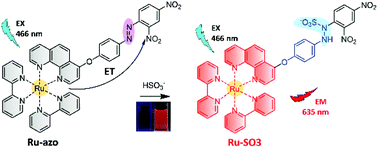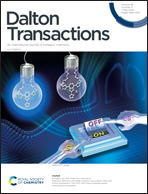Responsive ruthenium complex probe for phosphorescence and time-gated luminescence detection of bisulfite†
Abstract
Sensitive and selective quantification of specific analytes is of great significance in analytical and environmental sciences, as well as in the food industry. Herein, we report the design, synthesis, characterization, and application of a responsive ruthenium(II) complex probe, Ru-azo, for phosphorescence and time-gated luminescence (TGL) detection of bisulfite, an important additive in the food industry. Upon a specific nucleophilic addition reaction between bisulfite and the azo group of Ru-azo, a new ruthenium(II) complex, Ru-SO3, was obtained, which resulted in a remarkable increase in phosphorescence intensity, allowing the bisulfite detection to be achieved. In addition, long-lived emissions of Ru-azo (τ = 258 ns) and Ru-SO3 (τ = 261 ns) also enabled the TGL detection of bisulfite in autofluorescence-rich food samples. Through theoretical computations, the photoinduced electron transfer (PET) process within the ruthenium(II) complex was validated, which unveiled the rationality of the luminescence “off-on” response of Ru-azo to bisulfite. The probe showed advantages of good water solubility, and high sensitivity, selectivity and accuracy for responding to bisulfite, facilitating its application in phosphorescence and TGL detection of bisulfite in aqueous and food samples.



 Please wait while we load your content...
Please wait while we load your content...